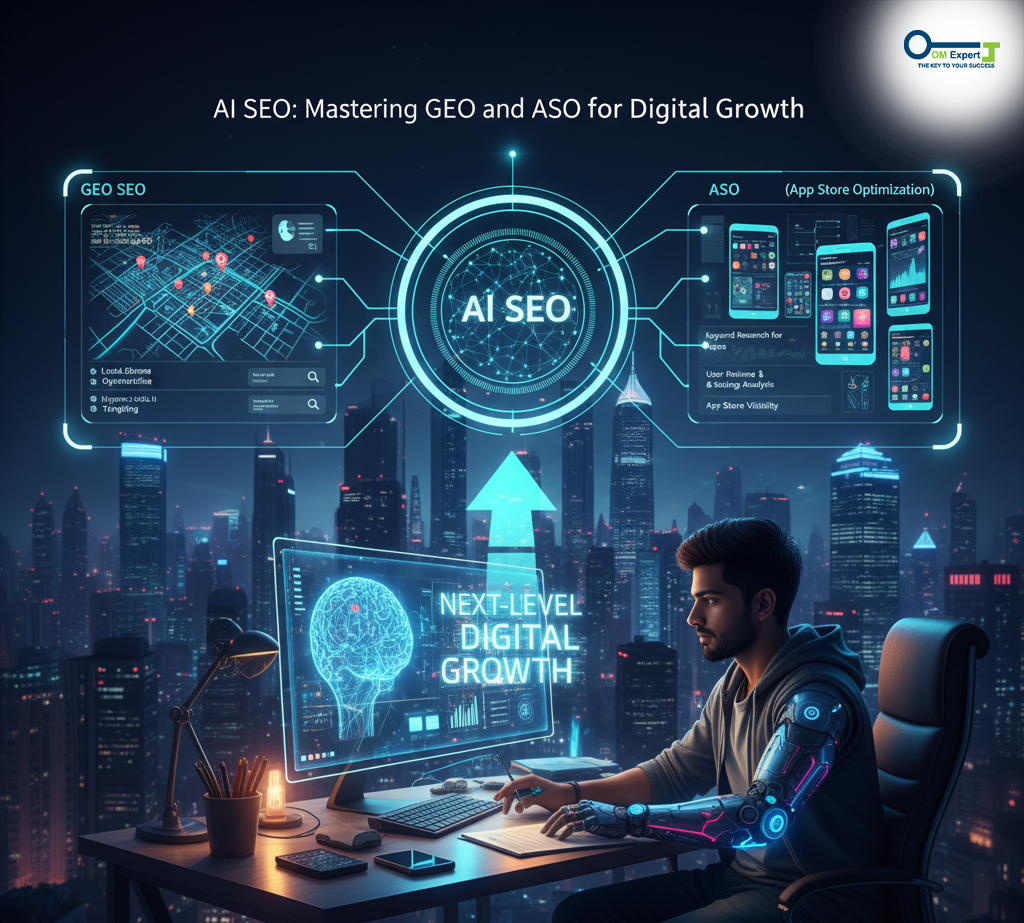AI SEO: Mastering GEO and ASO for Next-Level Digital Growth

The world of digital marketing now changes more rapidly than at any previous moment. Businesses can no longer rely on just traditional search engines in order to reach their audiences. While for years SEO has served as the centerpiece of online visibility, AI-powered search tools and generative AI platforms change how people find content, products, and services.
Platforms like ChatGPT, Gemini AI, among others, do not present a link list; instead, they give customized answers, multi-media, and insight to the user. Mastering AI SEO is no longer optional for those businesses that want to stay ahead.
This insider guide for AI SEO, GEO, and ASO is going to take your business up a notch and share with you how AI-driven ventures are predicated on the future of online visibility.
Why SEO Remains the Foundation of Digital Growth
Even as AI transforms search behavior, traditional SEO remains critical. It continues to drive traffic, build authority, and establish trust with audiences. AI SEO builds on this foundation, enhancing content discoverability across human and AI-driven searches.
Core Elements of Effective SEO
- Keyword Research: Identifying relevant terms your audience searches for is crucial. In AI SEO, long-tail and natural language queries become increasingly important as AI platforms prioritize conversational search.
- Technical SEO: Ensuring your website is fast, mobile-friendly, secure, and structured properly for crawling remains the backbone of visibility.
- Content Marketing: High-quality, informative content attracts readers, builds trust, and provides the source material for AI-powered answers.
- Link Building: Earning authoritative backlinks helps search engines and AI systems recognize your site as credible.
- User Experience (UX): A smooth, intuitive website keeps visitors engaged and signals value to both search engines and AI platforms.
By layering AI SEO strategies onto these fundamentals, businesses can ensure their content is discoverable on traditional search engines and AI-driven platforms alike.
The Emergence of AI-Powered Search
The search landscape has evolved dramatically. Surveys show that 82% of users find AI-powered search more helpful than traditional search, marking a paradigm shift in online discovery.
Key Features of AI Search
- Conversational Queries: Users now ask questions in natural, everyday language.
- Generative Answers: AI provides summarized content, multimedia, and contextual insights instead of just links.
- Instant Information: AI pulls answers from multiple sources quickly, creating faster and more precise user experiences.
This evolution means businesses can no longer rely only on Google rankings. Visibility now requires appearing in AI-driven answers, chatbots, and platforms that deliver generative responses.
Introducing AI SEO Terminology: GEO, ASO, and AISO
To navigate this new landscape, marketers are using specialized terms for AI-driven search optimization:
GEO – Generative Engine Optimization
GEO focuses on optimizing content so it appears in AI chatbots and generative platforms. By tailoring content for AI responses, businesses can gain visibility in conversational search, multimodal results (text + images), and personalized AI outputs.
ASO – Answer Search Optimization
ASO structures content to provide clear, concise, and accurate answers that AI platforms can extract efficiently. FAQs, Q&A sections, and structured data are key components.
AISO – AI Search Optimization
AISO is a broad term encompassing all strategies to improve visibility across AI search engines, including GEO and ASO. It represents a holistic approach to AI-driven digital growth.
AEO – Answer Engine Optimization
AEO ensures content is summarized accurately and displayed correctly in AI answers. This is particularly important for platforms like ChatGPT, which provide direct answers rather than linking to full pages.
How AI SEO Complements Traditional SEO

While new AI-era strategies are gaining popularity, they do not replace traditional SEO—they enhance it.
- SEO provides the content foundation that AI platforms pull from.
- GEO and ASO layer AI-specific optimizations on top of that foundation.
- AISO represents the strategic integration of both traditional and AI-focused SEO.
This combination ensures your brand is visible across Google, AI platforms, and other search channels.
Implementing AI SEO Strategies: Step-by-Step
To maximize digital growth, businesses should integrate AI SEO practices with classic SEO techniques.
Optimize Content for AI Queries
- Use long-tail keywords and natural language questions.
- Include FAQs, Q&A sections, and bullet points to make content AI-friendly.
- Provide context with synonyms, related terms, and entity references.
Enhance Technical SEO
- Ensure fast-loading, mobile-friendly, and secure websites.
- Use structured data (schema markup) for better AI comprehension.
- Maintain a logical site hierarchy to improve AI crawling efficiency.
Improve User Experience
- Deliver concise, informative content that AI and users prefer.
- Enhance readability and navigation to increase engagement.
- Incorporate videos, images, infographics, and other multimedia to complement textual content.
Monitor AI Search Trends
- Track AI platforms your audience uses.
- Analyze which queries trigger AI-generated answers.
- Adjust content strategies based on AI search insights using tools like Semrush and SurferSEO.
Integrate Traditional SEO With AI SEO
- Continue keyword research, link building, and content audits.
- Layer in GEO, ASO, and AISO optimizations.
- Align your team on consistent AI SEO strategies to avoid confusion.
The Role of GEO and ASO in Digital Growth
GEO and ASO are more than just industry buzzwords. They offer real, practical benefits for businesses that want to grow in today’s AI-driven search environment. GEO (Generative Engine Optimization) helps brands get discovered on AI chatbots and generative platforms by making content easier for AI systems to understand and reuse. It improves how your brand appears in AI-generated answers, product suggestions, and recommendations.
ASO (Answer Search Optimization) focuses on structuring content in a way that allows AI tools to pull accurate, clear answers from your website. This includes using FAQs, headings, and organized content formats that improve readability for both users and machines.
Together, GEO and ASO increase visibility, attract new users, and build authority across AI platforms. For example, a small eCommerce business added conversational FAQs, structured product content, and AI-friendly metadata. Within three months, it saw a 42% rise in AI-driven traffic while continuing strong growth from Google search results.
Why Traditional SEO Still Matters
Even as AI becomes dominant:
- Organic traffic from Google and other engines remains critical.
- Traditional SEO feeds content to AI platforms, providing high-quality sources for AI-generated answers.
- Ignoring SEO risks losing visibility on both traditional and AI-driven platforms.
Key Insight: SEO is the bridge between classic search and AI discovery, while GEO and ASO extend reach.
Tools and Techniques for AI SEO Success
Modern AI SEO requires a combination of tools, strategies, and analytics:
- Semrush: Keyword research, competitor analysis, and AI search insights.
- SurferSEO: Optimize content for AI-friendly structure and readability.
- ChatGPT and AI content platforms: Generate ideas, summaries, and content variations.
- Google Analytics & Search Console: Track traffic from AI search sources.
- Schema Markup: Helps AI extract content accurately.
- Multimedia Optimization: Videos, images, and infographics improve AI engagement.
Content Strategies for AI SEO
To succeed in AI SEO:
- FAQ-Centric Content: Break complex topics into AI-friendly Q&A sections.
- Conversational Copywriting: Use natural language for easier AI comprehension.
- Entity-Based Optimization: Include brands, products, locations, and key concepts that AI can link contextually.
- Internal Linking: Helps both AI and users discover related content.
- Content Updates: Refresh articles regularly to remain relevant for AI platforms.
Measuring AI SEO Performance
AI SEO requires new metrics alongside traditional KPIs:
- AI Visibility Score: Measures how often your content appears in AI answers.
- Click-Through from AI Sources: Track traffic from AI chatbots and platforms.
- Engagement Metrics: Time on page, bounce rate, and session duration indicate content value.
- SERP & AI Ranking: Monitor rankings for AI queries using AI-focused tools.
- Conversion Metrics: Track how AI-generated traffic converts into leads or sales.
Integrating AI SEO Into Your Digital Growth Plan
To achieve holistic digital growth:
- Blend SEO, GEO, ASO, and AISO into a single strategy.
- Educate your team on AI terminology and optimization methods.
- Use analytics tools to identify gaps and opportunities.
- Stay updated with AI search trends and algorithm updates.
This ensures sustained visibility, both on search engines and AI platforms, while maintaining traditional SEO authority.
Common Challenges in AI SEO

AI SEO comes with its own set of challenges that businesses must learn to manage. One major issue is acronym confusion. Terms like GEO, ASO, AISO, and AEO are often used interchangeably, which can make strategy planning unclear. Businesses should focus less on labels and more on practical actions.
Another challenge is content overload. AI platforms prefer clean, well-structured information instead of long, cluttered articles. Content must provide direct answers, organized sections, and easy-to-scan formatting.
Technical complexity also holds many teams back. Implementing schema markup, structured data, and AI-friendly formats requires technical knowledge and regular maintenance.
Finally, AI search changes fast. Algorithms, tools, and content expectations evolve constantly, making it necessary to update strategies regularly.
Tip: Stay consistent with AI SEO practices, focus on what users truly need, and prioritize clarity over complexity to overcome these challenges successfully.
The Future of AI SEO
AI SEO is not a temporary trend—it’s the evolution of search optimization. Key trends for the coming years include:
- Multimodal Search Optimization: Optimizing content for text, images, and video in AI responses.
- Personalized AI Recommendations: Tailoring content for user-specific AI queries.
- Voice Search and Conversational AI: Optimizing for spoken queries.
- AI-Generated Content Analysis: Ensuring your content remains unique and authoritative.
- Cross-Platform AI Visibility: Appearing in AI assistants, chatbots, SERPs, and social platforms.
Businesses adopting AI SEO early will have a competitive advantage, capturing audiences before competitors adapt.
Conclusion: AI SEO is the Future of Digital Growth
The digital marketing landscape is evolving rapidly. Traditional SEO remains crucial, but AI SEO, including GEO and ASO, is transforming how businesses grow online. By integrating AI-focused strategies, companies can remain visible across Google, chatbots, and AI platforms.
At Om Expert, we specialize in combining traditional SEO and AI SEO strategies to help businesses achieve sustainable digital growth. From optimizing content for AI platforms to enhancing user experience and monitoring AI trends, our solutions ensure your brand is discoverable, authoritative, and ready for the AI-powered future.
